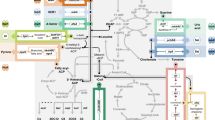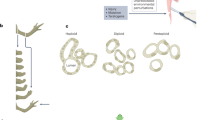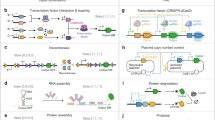Abstract
The ability to quickly and reliably engineer many-component systems from libraries of standard interchangeable parts is one hallmark of modern technologies. Whether the apparent complexity of living systems will permit biological engineers to develop similar capabilities is a pressing research question. We propose to adapt existing frameworks for describing engineered devices to biological objects in order to (i) direct the refinement and use of biological 'parts' and 'devices', (ii) support research on enabling reliable composition of standard biological parts and (iii) facilitate the development of abstraction hierarchies that simplify biological engineering. We use the resulting framework to describe one engineered biological device, a genetically encoded cell-cell communication receiver named BBa_F2620. The description of the receiver is summarized via a 'datasheet' similar to those widely used in engineering. The process of refinement and characterization leading to the BBa_F2620 datasheet may serve as a starting template for producing many standardized genetically encoded objects.
This is a preview of subscription content, access via your institution
Access options
Subscribe to this journal
Receive 12 print issues and online access
$209.00 per year
only $17.42 per issue
Buy this article
- Purchase on Springer Link
- Instant access to full article PDF
Prices may be subject to local taxes which are calculated during checkout



Similar content being viewed by others
References
Arkin, A. & Fletcher, D. Fast, cheap and somewhat in control. Genome Biol. 7, 114 (2006).
Dyson, F. The Darwinian interlude. Technology Review. <http://www.technologyreview.com/read_article.aspx?ch=specialsections&sc=stemcell&id=16368> (2005).
Rucker, R. Wetware. (Avon Books, New York, 1988).
Endy, D. Foundations for engineering biology. Nature 438, 449–453 (2005).
Sellers, W. On a uniform system of screw threads. J. Franklin Inst. 47, 344 (1864).
Knight, T. Idempotent vector design for standard assembly of Biobricks. MIT Synthetic Biology Working Group Technical Reports. <http://hdl.handle.net/1721.1/21168> (2003).
Endy, D., Deese, I. & Wadey, C. Adventures in synthetic biology. Nature 438, 449–453 (2005).
Alper, H., Fischer, C., Nevoigt, E. & Stephanopoulos, G. Tuning genetic control through promoter engineering. Proc. Natl. Acad. Sci. USA 102, 12678–12683 (2005).
Rosenfeld, N., Young, J.W., Alon, U., Swain, P.S. & Elowitz, M.B. Gene regulation at the single-cell level. Science 307, 1962–1965 (2005).
Texas Instruments. TTL logic: standard TTL, Schottky, low-power Schottky. (Texas Instruments Incorporated, Dallas, Texas, 1988).
Ward, A. & Halstead, R.H. Computation structures. (MIT Press, Cambridge, Massachusetts, USA, 1990).
Brindley, K. Sensors and transducers. (Heinemann Professional Publishing, Portsmouth, New Hampshire, USA, 1988).
de Silva, C.W. Sensors and Actuators: Control System Instrumentation. (CRC Press, Boca Raton, Florida, 2007).
Boettcher, K.J. & Ruby, E.G. Detection and quantification of Vibrio fischeri autoinducer from symbiotic squid light organs. J. Bacteriol. 177, 1053–1058 (1995).
Winson, M.K. et al. Construction and analysis of luxCDABE-based plasmid sensors for investigating N-acyl homoserine lactone-mediated quorum sensing. FEMS Microbiol. Lett. 163, 185–192 (1998).
French, C. et al. Arsenic biosensor: a step further. BMC Syst. Biol. 1 Suppl 1, S11 (2007).
Guet, C.C., Elowitz, M.B., Hsing, W. & Leibler, S. Combinatorial synthesis of genetic networks. Science 296, 1466–1470 (2002).
Mayo, A.E., Setty, Y., Shavit, S., Zaslaver, A. & Alon, U. Plasticity of the cis-regulatory input function of a gene. PLoS Biol. 4, e45 (2006).
Anderson, J.C., Voigt, C.A. & Arkin, A.P. Environmental signal integration by a modular AND gate. Mol. Syst. Biol. 3, 133 (2007).
Shaner, N.C., Steinbach, P.A. & Tsien, R.Y. A guide to choosing fluorescent proteins. Nat. Methods 2, 905–909 (2005).
BBa_F2620. Registry of Standard Biological Parts. <http://partsregistry.org/Part:BBa_F2620>
Nealson, K.H. & Hastings, J.W. Bacterial bioluminescence: its control and ecological significance. Microbiol. Mol. Biol. Rev. 43, 496–518 (1979).
Nealson, K.H. Autoinduction of bacterial luciferase. Occurrence, mechanism and significance. Arch. Microbiol. 112, 73–79 (1977).
Engebrecht, J. & Silverman, M. Identification of genes and gene products necessary for bacterial bioluminescence. Proc. Natl. Acad. Sci. USA 81, 4154–4158 (1984).
Schaefer, A.L., Hanzelka, B.L., Eberhard, A. & Greenberg, E.P. Quorum sensing in Vibrio fischeri: probing autoinducer-LuxR interactions with autoinducer analogs. J. Bacteriol. 178, 2897–2901 (1996).
Weiss, R. & Knight, T.F. Engineered communications for microbial robotics. in DNA 2000, Lecture Notes in Computer Science, vol. 2054, DNA Computing: 6th International Workshop on DNA-Based Computers, Leiden, The Netherlands, June 13–17, 2000 (ed. Condon, A.) 1–16 (Springer-Verlag, Berlin, 2001).
Andersen, J.B. et al. GFP-based N-acyl homoserine-lactone sensor systems for detection of bacterial communication. Appl. Environ. Microbiol. 67, 575–585 (2001).
Lindsay, A. & Ahmer, B.M.M. Effect of sdiA on biosensors of N-acylhomoserine lactones. J. Bacteriol. 187, 5054–5058 (2005).
Collins, C.H., Arnold, F.H. & Leadbetter, J.R. Directed evolution of Vibrio fischeri LuxR for increased sensitivity to a broad spectrum of acyl-homoserine lactones. Mol. Microbiol. 55, 712–723 (2005).
Basu, S., Gerchman, Y., Collins, C.H., Arnold, F.H. & Weiss, R. A synthetic multicellular system for programmed pattern formation. Nature 434, 1130–1134 (2005).
You, L., Cox, R.S., Weiss, R. & Arnold, F.H. Programmed population control by cell-cell communication and regulated killing. Nature 428, 868–871 (2004).
Glick, B.R. Metabolic load and heterologous gene expression. Biotechnol. Adv. 13, 247–261 (1995).
Rosenfeld, N., Young, J.W., Alon, U., Swain, P.S. & Elowitz, M.B. Accurate prediction of gene feedback circuit behavior from component properties. Mol. Syst. Biol. 3, 143 (2007).
Collins, C.H., Leadbetter, J.R. & Arnold, F.H. Dual selection enhances the signaling specificity of a variant of the quorum-sensing transcriptional activator LuxR. Nat. Biotechnol. 24, 708–712 (2006).
Yokobayashi, Y., Weiss, R. & Arnold, F.H. Directed evolution of a genetic circuit. Proc. Natl. Acad. Sci. USA 99, 16587–16591 (2002).
Haseltine, E.L. & Arnold, F.H. Synthetic gene circuits: design with directed evolution. Annu. Rev. Biophys. Biomol. Struct. 36, 1–19 (2007).
Acknowledgements
We thank T. Knight; R. Rettberg; members of the Endy, Knight and Sauer labs and staff of the Registry of Standard Biological Parts for discussions, advice and materials throughout the work. We thank R. Brent, U. RajBhandary, C. Smolke, B. Studier and anonymous reviewers for comments on earlier versions of this manuscript. This research was supported by grants to D.E. from the US National Science Foundation, Defense Advanced Research Projects Agency and National Institutes of Health. B.C. was supported by a National University of Ireland training fellowship. Additional support was provided by the Massachusetts Institute of Technology.
Author information
Authors and Affiliations
Contributions
B.C. and D.E. initiated the work. B.C., D.E. and A.L. designed the experiments. B.C. and A.L. performed the experiments. B.C., A.L. and D.E. analyzed the data and wrote the paper.
Corresponding author
Supplementary information
Supplementary Text and Figures
Figures 1–5, Tables 1–3 (PDF 1560 kb)
Rights and permissions
About this article
Cite this article
Canton, B., Labno, A. & Endy, D. Refinement and standardization of synthetic biological parts and devices. Nat Biotechnol 26, 787–793 (2008). https://doi.org/10.1038/nbt1413
Published:
Issue Date:
DOI: https://doi.org/10.1038/nbt1413
This article is cited by
-
Integrase-mediated differentiation circuits improve evolutionary stability of burdensome and toxic functions in E. coli
Nature Communications (2022)
-
Space bioprocess engineering on the horizon
Communications Engineering (2022)
-
Absolute protein quantification using fluorescence measurements with FPCountR
Nature Communications (2022)
-
A standardized genome architecture for bacterial synthetic biology (SEGA)
Nature Communications (2021)
-
Towards an engineering theory of evolution
Nature Communications (2021)



